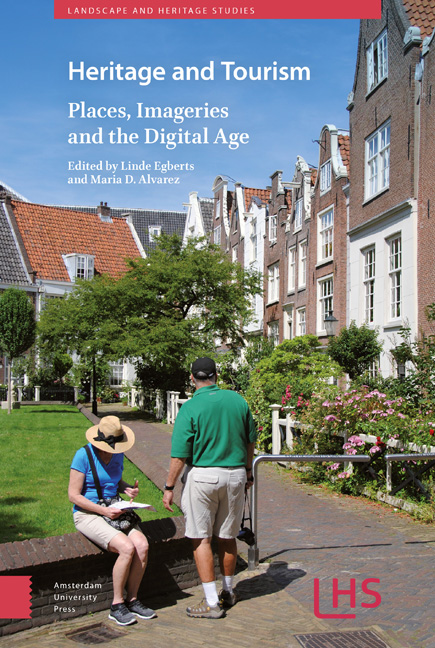Book contents
- Frontmatter
- Dedication
- Contents
- List of Figures and Tables
- Foreword
- 1 Tourism and Heritage: Crafting Experiences Through Innovation
- 2 Tourism Conflicts and Conflict Tourism: Curating “Holoscapes” in Europe’s Age of Crisis
- 3 Heritage Landscapes of Hiroshima and Nagasaki
- 4 Revealing and Presenting the Past(s) for the Public: Fethiye Mosque and Museum as a Cultural Heritage Site in Istanbul
- 5 Who Takes the Lead in Initiating Cooperation in a Cultural Network and Why?: The case study of a Rural Finnish Destination
- 6 Sustainability of Heritage-Tourism Destinations: A Demand-Based Perspective on Cusco, Peru
- 7 Localising National Tourism Websites: The case of World Heritage sites
- 8 Enhancing the Tourist Heritage Experience through “In-Situ”, Customisable, 3D-Printed Souvenirs
- 9 Tracking the Heritage Tourist: Heritage tourism and Visiting Patterns in a Historic City
- 10 The Construction of a Tourist-Historic Icon: The case of the Palace of Westminster, London
- 11 Conclusion
- Index
11 - Conclusion
Published online by Cambridge University Press: 22 December 2020
- Frontmatter
- Dedication
- Contents
- List of Figures and Tables
- Foreword
- 1 Tourism and Heritage: Crafting Experiences Through Innovation
- 2 Tourism Conflicts and Conflict Tourism: Curating “Holoscapes” in Europe’s Age of Crisis
- 3 Heritage Landscapes of Hiroshima and Nagasaki
- 4 Revealing and Presenting the Past(s) for the Public: Fethiye Mosque and Museum as a Cultural Heritage Site in Istanbul
- 5 Who Takes the Lead in Initiating Cooperation in a Cultural Network and Why?: The case study of a Rural Finnish Destination
- 6 Sustainability of Heritage-Tourism Destinations: A Demand-Based Perspective on Cusco, Peru
- 7 Localising National Tourism Websites: The case of World Heritage sites
- 8 Enhancing the Tourist Heritage Experience through “In-Situ”, Customisable, 3D-Printed Souvenirs
- 9 Tracking the Heritage Tourist: Heritage tourism and Visiting Patterns in a Historic City
- 10 The Construction of a Tourist-Historic Icon: The case of the Palace of Westminster, London
- 11 Conclusion
- Index
Summary
This book has focused on the intricate but symbiotic relationship between heritage and tourism. As reviewed in the ten chapters included in this work, heritage feeds tourism with its stories and myths, ties to a past that is often glorious but may also be troubled and dark. This imagery is carried out and extended with the help of new technologies that play an intrinsic role in creating experiences for the consumption of the visitors. Thus, in cultural studies, geography, and cultural anthropology, heritage tourism is often framed and perceived as a quest for something authentic, as well as a means of escaping from modernity's sense of alienation. It is associated with turning heritage into a spectacle, an exercise in staged authenticity – in other words, the replacement of a formerly vital tradition that is perceived as more authentic (MacCannell, 1973). Moreover, some believe that the processes of commodification pollute existing cultures (Meethan, 2011). This way of thinking leads Ashworth & van Vroger to assert that “heritage is important to tourism but tourism is not important to heritage” (Ashworth & van Vroger, 2005, p. 196).
Without denying such processes of heritagisation and commodification, we regard this nostalgia and this anxiety about loss of authenticity inherent to what MacDonald calls the memory phenomenon, which encompasses various ways of giving the past a place in the present, whether the vehicle for this be history, memory, or heritage (MacDonald, 2013). The contributions in this book suggest that the relationship between heritage and tourism is more complex than the one Ashworth & van Vroger (2005) perceive. The introduction points out some of the elements that enter into it, and our contributors reflect more deeply on various aspects of this complex connection, which is also the subject of the Heritage Tourism and Hospitality International Conference series that gave rise to this volume.
While we have looked at the role and support that heritage bestows on tourism, the book also contends that tourism has the potential to give meaning to heritage resources. As such, the attention of tourists to local heritage can be a source of communal pride, an acknowledgement of local traditions and practices on the part of a wider audience.
- Type
- Chapter
- Information
- Heritage and TourismPlaces, Imageries and the Digital Age, pp. 215 - 220Publisher: Amsterdam University PressPrint publication year: 2018



